Contributory members are able to log private notes and comments about each site
Sites Anne T has logged. View this log as a table or view the most recent logs from everyone
Cockleroy Hill (Beecraigs)
Trip No.49 Entry No.3 Date Added: 22nd May 2019
Site Type: Hillfort
Country: Scotland (West Lothian)
Visited: Yes on 22nd Sep 2017. My rating: Condition 2 Ambience 3 Access 4
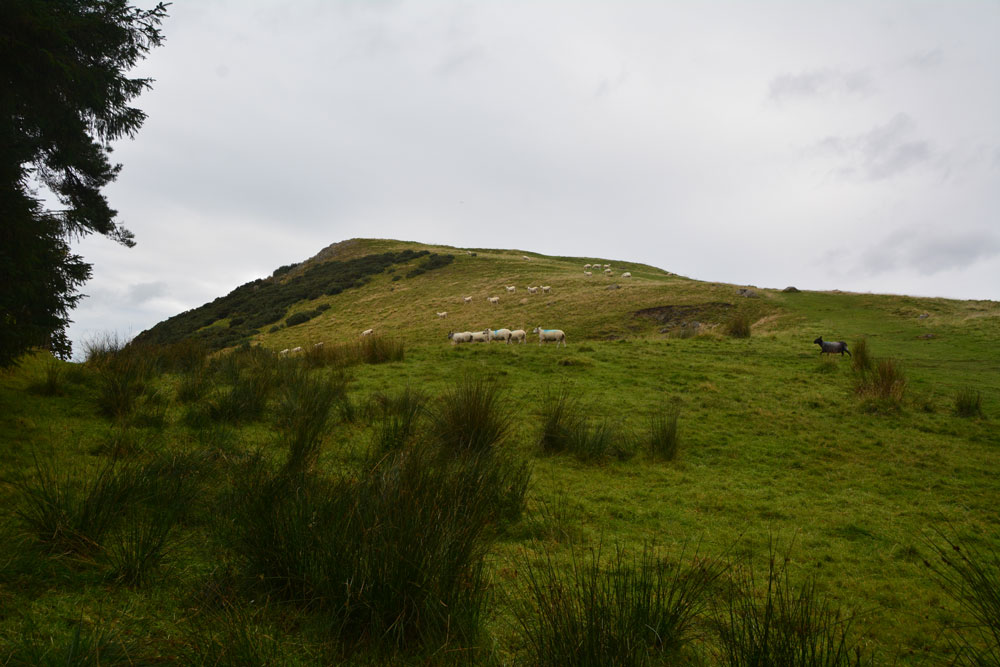
Cockleroy Hill (Beecraigs) submitted by Anne T on 5th Oct 2017. First view of Cockleroy Hillfort, having walked from the small car park to the gate into the field. The hill rises reasonably steeply up to 278 metres and has a trig point and view point on top.
(View photo, vote or add a comment)
Log Text: Cockleroy Hillfort, Beecraigs Country Park: From Lower Craigmailing Socketed Stone, we drove north past the Korean War Memorial to Beescraig Country Park. There was a small car park at about NS 99445 74270, where a path led through the forest, leading to a gate into the field containing the hillfort.
According to the Scotsman of 9th December 2012, Cocklroy means “the hat of the kings”. Situated in Beecraigs Country Park forest, there is a climb of 278 metres to the top and a mown path goes straight up the hill to the top of the fort, where there is a viewpoint. I wasn’t feeling too good, so opted out half way up the climb. Andrew continued up to the trig point at the top, and had great views across Lochcote Reservoir to the south west and the Forth Bridges at Queensferry to the north east.
Andrew said there wasn’t much to see of the fort itself – there were very little signs on the ground. I sat on the large stones about half way up the slope, at first thinking they were defensive ditches and banks, but were in fact modern quarries, when I looked closer!
Holy Trinity (Rolleston)
Trip No.129 Entry No.2 Date Added: 21st May 2019
Site Type: Ancient Cross
Country: England (Nottinghamshire)
Visited: Yes on 10th May 2019. My rating: Condition 3 Ambience 4 Access 4
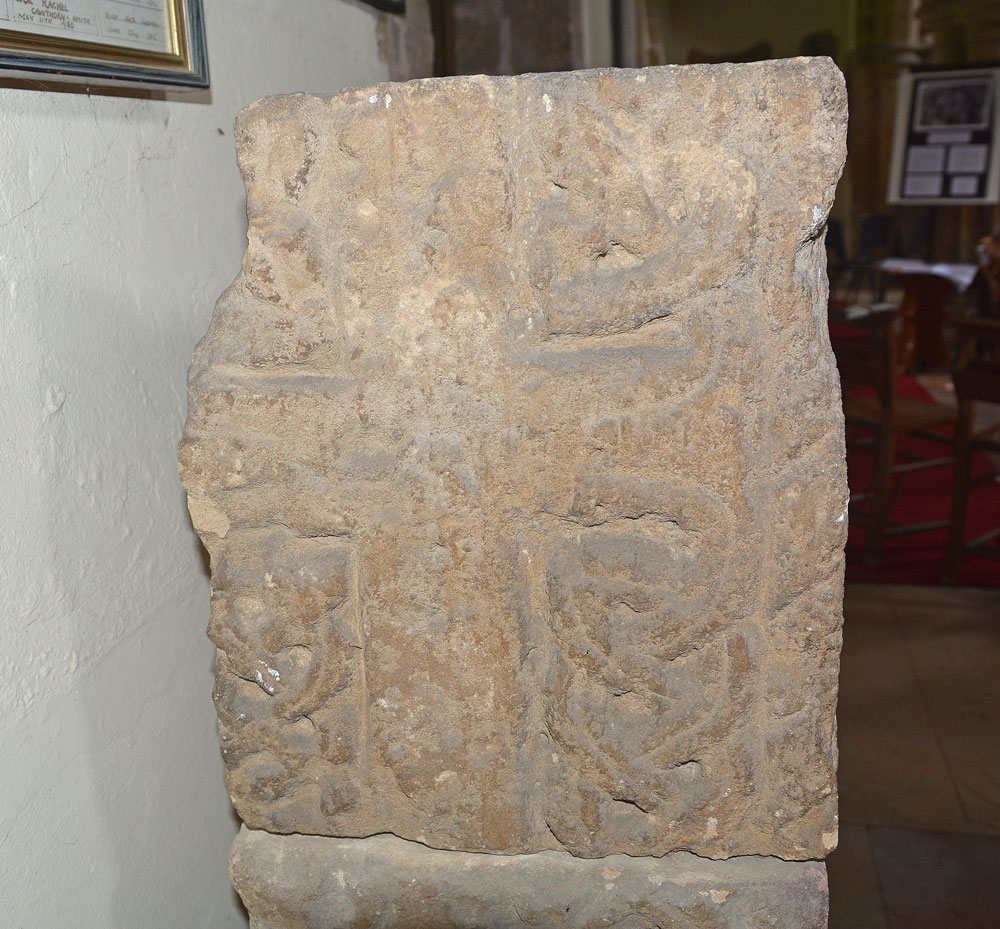
Holy Trinity (Rolleston) submitted by Anne T on 21st May 2019. The western side of the top-most block of the three making up the remains of this stone cross.
(View photo, vote or add a comment)
Log Text: Cross Shaft Fragments and Cross Slabs, Holy Trinity, Rolleston: By the time we’d photographed the sundial in the churchyard then walked up to the village cross, the church had been opened (thankfully) and we let ourselves in. The cross shaft was immediately opposite the south door into the church, although in a really difficult position to photograph (between a heavy wooden desk with information leaflets and a fire extinguisher). The most ornate section of the cross was to its western side, so after Andrew had moved the chairs, I virtually had to squeeze myself in next to the desk and squat down as best I could to capture the carvings – not the most elegant of positions!
It wasn’t until after I had photographed the cross and was making my way towards the fragments in the eastern wall of the northern aisle that I realised the chairs in the church had been set up in a labyrinth pattern. We did have to move some of the chairs to access several parts of the church, but made sure we put the chairs back exactly where we found them.
Thank goodness I had my printouts with Peter Ryder’s drawings and descriptions, as we would have missed a lot here! We’d spotted one or two of the most obvious carved stones built into the external fabric. However, now knowing how much was on the external walls, we went round the outside again and spotted so much more.
Rolleston Cross
Trip No.129 Entry No.1 Date Added: 21st May 2019
Site Type: Ancient Cross
Country: England (Nottinghamshire)
Visited: Yes on 10th May 2019. My rating: Condition 3 Ambience 3 Access 5
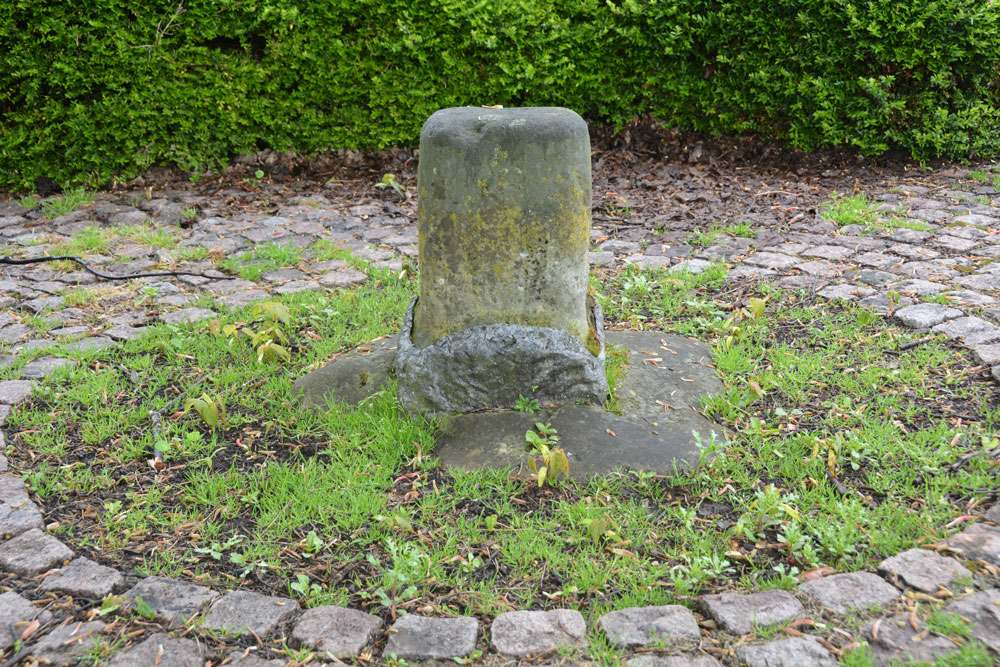
Rolleston Cross submitted by Anne T on 21st May 2019. Close up of the stump of the Rolleston Village Cross. Pastscape tells us it once had shields carved into it, although these are no longer visible, and they do not tell us who these belonged to. Dated to the 14th century, the local stocks were once said to be nearby.
(View photo, vote or add a comment)
Log Text: Rolleston Cross: This was our first stop on our way down to Dartmoor. Having stopped off in Newark for a very early breakfast, we arrived in Rolleston at 08:30, only to find (not surprisingly!) that the church had not yet been opened. After having photographed the sun dial in the churchyard of Holy Trinity, we walked up to find this old village cross, which I completely missed the first time round, as it blended in with the surrounding pavement and benches!
The very sad remains of an old village cross, but another site to have ticked off the list. By the time we'd photographed this cross stump, we walked back to Holy Trinity to find it now open.
The Hanging Stone (Haydon)
Trip No.128 Entry No.2 Date Added: 7th May 2019
Site Type: Standing Stone (Menhir)
Country: England (Northumberland)
Visited: Yes on 6th May 2019. My rating: Condition 3 Ambience 4 Access 4
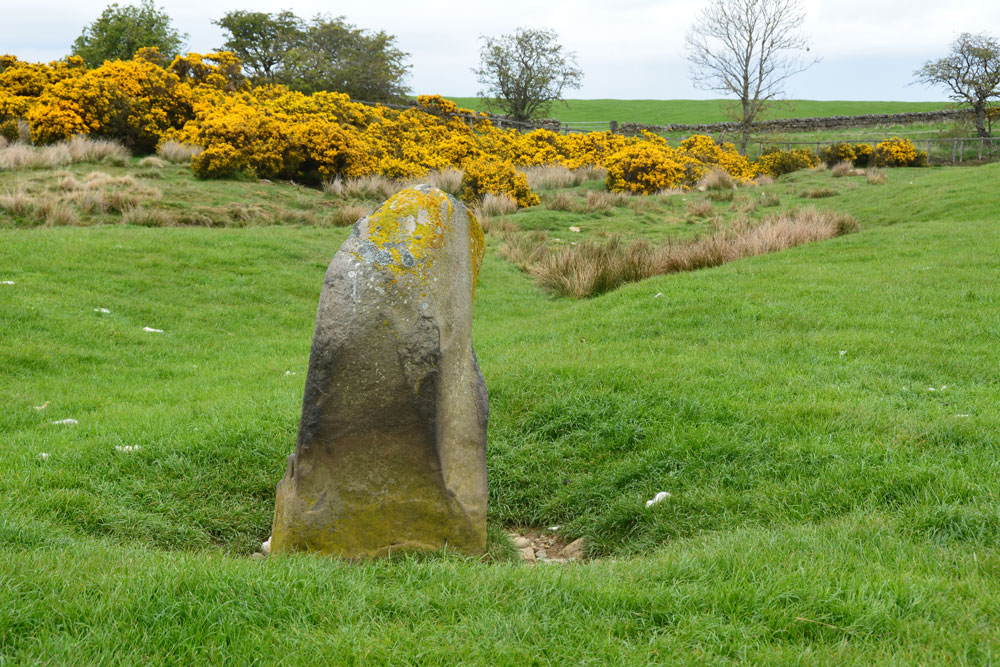
The Hanging Stone (Haydon) submitted by Anne T on 7th May 2019. Standing just behind the stone looking north east. The stone is in a slight dip in the landscape and a (water?) channel runs almost from the base of the stone to the north east, where it joins another small stream. I wondered if at some point the stone marked the location of a spring, although this is not shown on the early OS maps. From here, it looks as if the top half of the stone is 'hooked'
(View photo, vote or add a comment)
Log Text: The Hanging Stone, south of Haydon Bridge: We tried to find the Treacle Well (Traking Well) in Slaley, but despite an old footpath opposite the church being shown on the OS map, we couldn’t find our way through the houses to see it, so headed off through Hexham and off west on the B6305 to find The Hanging Stone.
This is marked on the OS map; Andrew found it on the 1860 map of the area, so it has been there a long time. There are no references to it on HE (although it is marked on their map), and only the briefest of mentions on Pastscape.
This stone wasn’t what I was expecting. I half thought that we’d see a flat stone marking the site of a gallows, not a standing stone! But it is very definitely a standing stone, and one that seems to have been here for some considerable time.
The road was very busy and the cars very fast. We did manage to bump up onto the soft verge, but for safety should have pulled up on the driveway up to the farm. The entrance to the field is at NY 88081 61695. After photographing the stone over the stone wall, I didn’t fancy trekking all the way up to the farm house in the distance, so took a chance and let myself into the field.
The stone is located in a dip, below current ground level, and has stones packed around its base. To its north east a rounded channel runs off to join a stream or modern field drain, as if the stone marked the start of a spring at some point.
St George's Well (Minsteracres)
Trip No.128 Entry No.1 Date Added: 7th May 2019
Site Type: Holy Well or Sacred Spring
Country: England (Northumberland)
Visited: Yes on 6th May 2019. My rating: Condition 3 Ambience 4 Access 4
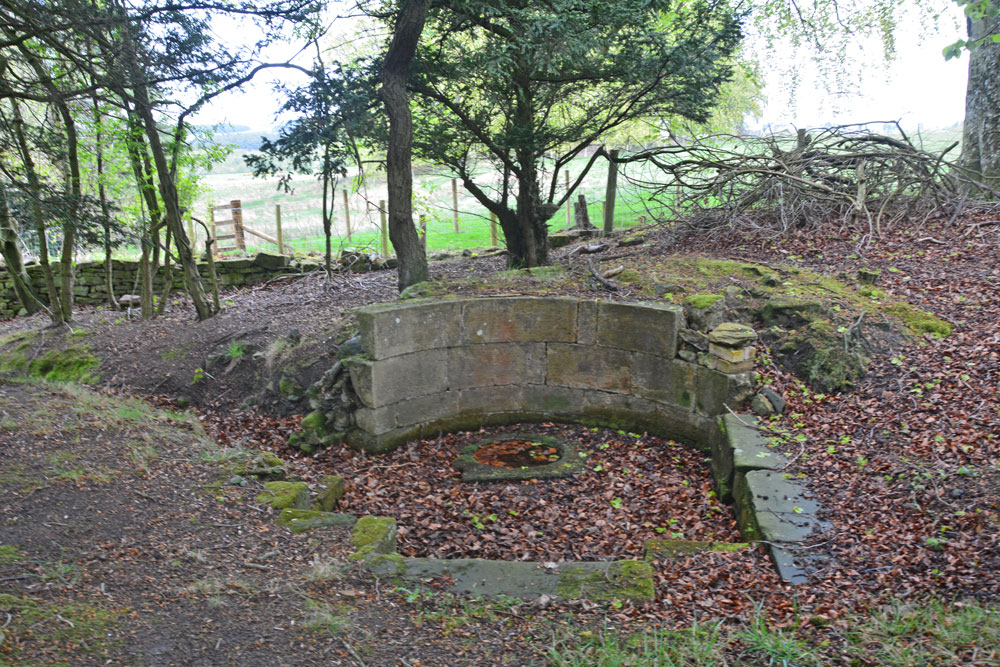
St George's Well (Minsteracres) submitted by Anne T on 7th May 2019. Getting closer, the structure of the well emerges from the surrounding tall trees. There is a semi-circular back wall, which has no exit tap or pipe; water must emerge directly from the ground into the small, circular well basin inside a larger, paved well pool.
(View photo, vote or add a comment)
Log Text: St George's Well, Minsteracres: Minsteracres had an open day today between 11am and 4pm, so we decided to drive up and see if we could find the well. I understood that it was located near to the chapel, but this was mistaken, as we found out on arrival.
Driving up the private road from the A68, we parked just past the cattle grid about 200m away from the main buildings, parked on the grass alongside the vegetable garden to our north, and walked back to The Shrubbery, a woodland with specimen and ornamental trees and two signposted walks.
With only a rough grid reference to guide us, but with the OS map in hand, it quickly became apparent that the well wasn’t in The Shrubbery, so we made our way back to the road and walked a little back towards the A68, heading north-north-east. In a small wood to our right hand side, the well became quickly apparent. I quickly recorded the waypoint on our GPS.
Whilst there was water in the pool, there was no water bubbling into the well pool. The well had a fairly large ditch running from it, so there appears to still be a fair flow of water from it at certain times.
Someone had recently been clearing away weeds and shrubs from the area. Scrapping away some of the leaves at the base of the steps into the well basin, water quickly flowed in to fill up the space where the leaves had been, although there was no evidence of flow.
Fair Helen's Tombstone
Trip No.127 Entry No.2 Date Added: 7th May 2019
Site Type: Marker Stone
Country: Scotland (Dumfries and Galloway)
Visited: Yes on 2nd May 2019. My rating: Condition 3 Ambience 4 Access 3

Fair Helen's Tombstone submitted by Anne T on 7th May 2019. Fair Helen's tombstone (foreground), with Adam Fleming's behind. The large metal signpost gives details of the tragedy, now immortalised by Sir Walter Scott in his epic poem.
(View photo, vote or add a comment)
Log Text: Fair Helen's Tombstone: This ‘monument’ is in two parts, the first of which came as a complete surprise, to our west, just off the path in a clearing, just above Kirtle Water.
For the legend of Fair Helen of Kirkconnel see: Fair Helen's Legend and Sir Walter Scott's epic poem.
This was a simple gravestone with a plaque on it, which reads: “In memory of fair Helen of Kirkconnel as well as Richard Bell and Adam Fleming who were involved in the tragedy which took place here. Erected by Clan Bell descendants. Irving Bell. Founder”.
Walking into this small, overgrown but very atmospheric, graveyard, with its tumbled ruins, I struggled to find Fair Helen’s Tombstone, but Andrew pointed it out – right behind a large metal sign announcing this is “Kirkconnel Churchyard”. The sign reads: “In the ballad “Fair Helen of Kirkonnel”, Adam Fleming’s Lover Helen was shot by mistake by a rival in Kirkconnel churchyard. The bullet was meant for Adam, who promptly killed him. Adam was later buried beside Helan and this is his tombstone: Hic Jacet Adam Flemeng. The adjacent uninscribed stone is Helen’s; and the nearby late-medieval cross is called “Fair Helen’s Cross”, marking the site of her death. / The romantic story of the ballad might be an 18th century invention, and the association of the monuments in the churchyard with the ballad’s characters is questionable”.
Hoddom Parish Church
Trip No.127 Entry No.1 Date Added: 6th May 2019
Site Type: Sculptured Stone
Country: Scotland (Dumfries and Galloway)
Visited: Yes on 2nd May 2019. My rating: Condition 2 Ambience 2 Access 4

Hoddom Parish Church submitted by Anne T on 6th May 2019. A close up of the stone, taken with my zoom lens. I'm still trying to find out more details about where it came from and its age. The Canmore record mentions this church replaced an earlier one built in 1610, "of which fragments remain", but nothing more. Other fragments have been lost, and a Roman altar has been built into the porch of the new parish church at Hoddom.
(View photo, vote or add a comment)
Log Text: Sculptured Stone at Hoddom Old Parish Church: Our first stop of the day, and a strange place. A church in ruins, boarded up, although with parts of the churchyard really nicely tended – presumably because of the war graves.
Sitting on the southern side of the B725 to the south west of Ecclefechan, we parked in the layby outside the main gates into the churchyard, immediately next to the ruins. It took us ages to find the location of the sculptured stone, and trying to describe its location is a little tricky as the church is built in the shape of a square cross, orientate N-S, E-W. The stone is built into the outside corner of the eastern wall of the southern 'arm' and the south wall of the eastern 'arm'. We were unable to get right up to it because of the proximity of the railed family grave enclosure, although we succeeded in knocking some brambles down from the front of the stone so we could view it.
Fair Helen's Cross (Kirkconnel)
Trip No.127 Entry No.4 Date Added: 5th May 2019
Site Type: Ancient Cross
Country: Scotland (Dumfries and Galloway)
Visited: Yes on 2nd May 2019. My rating: Condition 3 Ambience 4 Access 3

Fair Helen's Cross (Kirkconnel) submitted by Anne T on 5th May 2019. First view of Fair Helen's Cross (not to be confused with the nearby Fair Helen's tombstone), hidden deep in the shrubbery, to the east of Kirtle Water, and north west of the Old Parish Church of Kirkconnel and its atmospheric graveyard.
(View photo, vote or add a comment)
Log Text: Fair Helen's Cross, Kirkconnel Old Church: It was a beautiful walk from the small parking area provided at about NY 25239 74833. We let ourselves through the kissing gate and followed the footpath which ran just to the east of Kirtle Water, and a pasture field with sheep and young lambs to our right. The very dark storm clouds gathering to the north east made a fantastic backdrop to the mature trees in the field.
Along the footpath, we were distracted by a modern tombstone about half way along our route to Old Kirconnel Church. We also stopped to admire the wonderful trees, with all their different colours, from a soft pink of a newly emerging copper beech tree, flowering cherries, silver birches and horse chestnuts. Eventually stumbling upon a very large marble tombstone at the entrance to the old churchyard, we let ourselves in and started exploring.
Having missed, at first, Fair Helen's Tombstone, and having to have it pointed out to me (well, it was hidden by a large metal signpost immediately in front of it), I walked round the ruins of the old church whilst Andrew went to search for the cross. "You'll need a machete", were his words on his return.
Walking through the kissing gate in the far north western corner of the churchyard, we walked 20-30m north along the path until the vague outline of the cross appeared behind the shrubbery. It didn't help that the largest tree next to the cross was a holly - very prickly!
As we arrived at the cross, the rain started to pelt down. Fortunately, the shower didn't last very long, and after taking photographs of this old village cross, we went back to admire and photograph the unusual grave markers in the churchyard.
St Michael's Church (Warden)
Trip No.126 Entry No.3 Date Added: 5th May 2019
Site Type: Ancient Cross
Country: England (Northumberland)
Visited: Yes on 1st May 2019. My rating: Condition 3 Ambience 4 Access 4
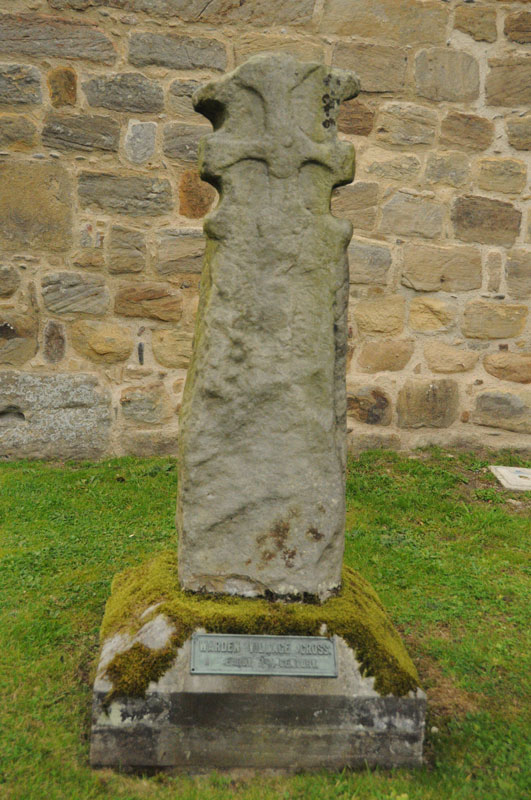
St Michael's Church (Warden) submitted by Anne T on 4th Sep 2014. The 7th century cross at the west side of the porch of St. Michaels, by the Saxon tower.
(View photo, vote or add a comment)
Log Text: St Michael and All Saints, Warden: Anglo Saxon Sculptured Stones, including The Warden Man and Hammerhead Churchyard Cross: I last visited this church on 3rd September 2014, when I was almost new to the Portal, and hadn’t yet come across Pastscape, Historic England or the Corpus of Anglo Saxon Stone Sculpture databases, so taking Andrew back here was a very pleasant surprise, as I learned an awful lot about these stones.
Well worth a repeat visit!
St Michael's Church (Warden)
Date Added: 5th May 2019
Site Type: Ancient Cross
Country: England (Northumberland)
Visited: Yes on 3rd Sep 2014. My rating: Condition 4 Ambience 4 Access 5
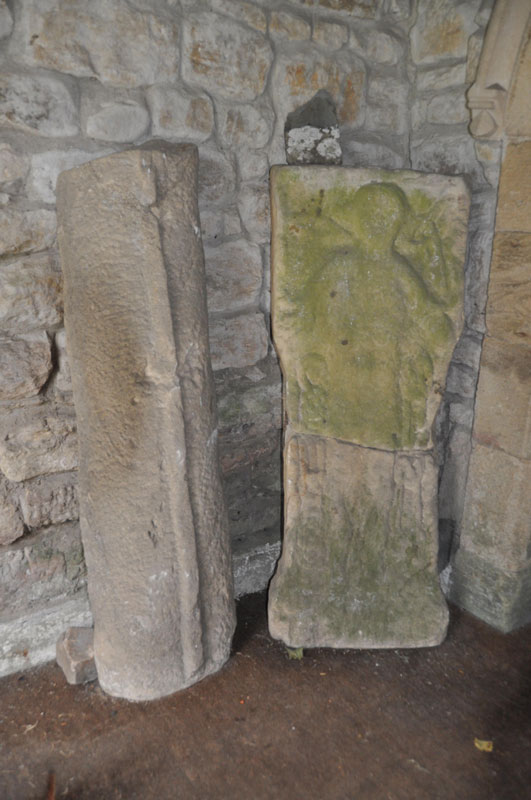
St Michael's Church (Warden) submitted by Anne T on 4th Sep 2014. The Warden Man, carved on a stone split from a Roman altar, situated on the western wall of the porch. Another grave cover stands to it's left hand side in this image.
(View photo, vote or add a comment)
Log Text: St Michael's Church, Warden, Northumberland: On the way back from Robin Hoods' Holy Well at Colwell, I detoured via Warden, a church we’ve visited before whilst visiting the Roman enclosure on the hill above Warden, but not really seen. On this last visit, on approaching St Michael’s, we heard a saxophone being played nearby – the same tune repeated over and over (and very badly (sorry, player!)). As we were going into the church, another couple were coming out. The noise of the saxophone got louder and louder, and a man appeared to serenade us. He proved a bit of a nuisance, so we escaped to the Boat pub for a drink, only to be closely followed by the saxophone and it’s player who then sat next to us.
The current church is 18th century, but built on much older foundations, originally thought to be the site of the oratory of the Anglo-Saxon saint St. John of Beverley.
On today's visit, I met a lady going into the church with some leaflets, and got chatting to her. She told me the same man still lives in the village, and she’d just come from his house. She also told me the Parish had just had the church restored and how proud they were of it now, pointing out the 7th century cross at the south side of the tower, by the porch.
The lady didn’t know anything about the Warden Man, so as we went into the porch, I spotted it and pointed it out. “Perhaps we should scrape the moss of it”, she exclaimed. I gulped loudly. “I think you should leave it as it is – you need to ask a professional before doing that”.
There are some fascinating features within the church – the 11th century arch at the base of the tower includes a roman stone, and the Saxon gravestone which is on the floor in the chancel (northern wall, next to the choir stalls, just before the altar rails).
The Saxon gravestone, in the right light, shows tegulations (a word I hadn’t heard of before I picked up the guide book for the church! – “use light and shade to create a distinctive appearance”) to look like a tiled roof. Outside, there is the 7th century cross (which the Keys To The Past record says is 7th to 11th century), gravestones with iron hoops over them to prevent body-snatchers taking the bodies and a Saxon tower.
In the porch, opposite the Warden Man, is a collection of grave stones. There was a really interesting small roundel, with what looked like knot-work on it. I was unable to find out any more about the date of these.
Warden Hill Hillfort
Trip No.126 Entry No.1 Date Added: 5th May 2019
Site Type: Hillfort
Country: England (Northumberland)
Visited: Yes on 1st May 2019. My rating: Condition 2 Ambience 4 Access 4
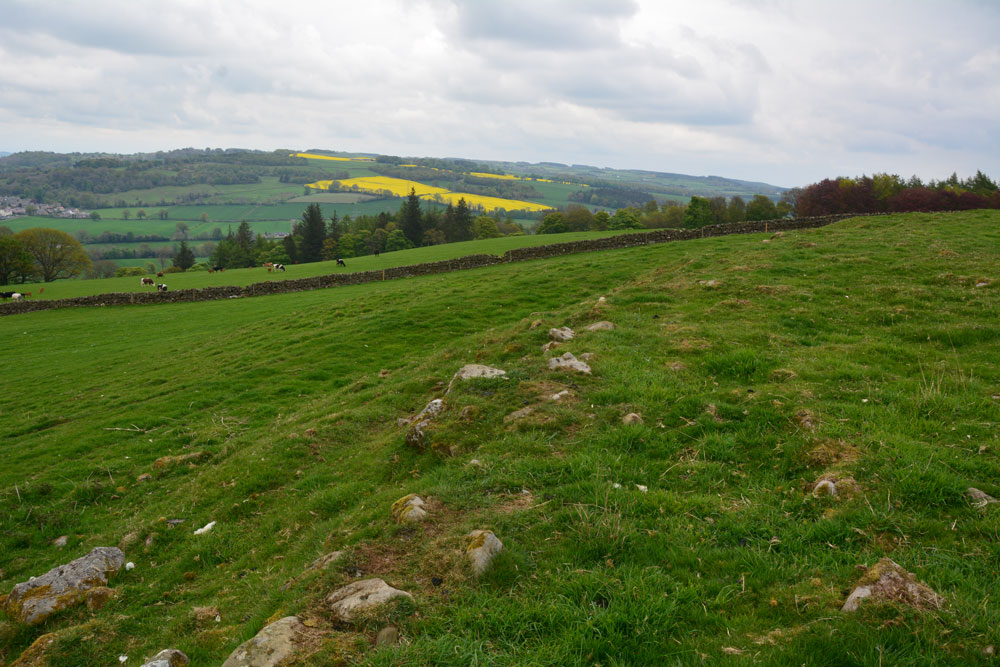
Warden Hill Hillfort submitted by Anne T on 5th May 2019. Standing almost on the north western corner of the hillfort, looking north east over the northern rampart, with the Tyne Valley in the distance.
(View photo, vote or add a comment)
Log Text: Warden Hill Hillfort: Homer’s Lane is very narrow, so we struggled to park the car. We eventually ended up bumped up on the verge at the wide entrance to a farm house at NY 91187 67190, ensuring there was plenty of room for tractors, trailers and other traffic to get past.
Walking back to the start of the footpath at NY 91217 67247, we used the kissing gate and walked up hill, turning left onto the well-marked path, zig-zagging through what is virtually a small village at High Warden (there are so many signposts and ‘private’ signs’ people must have become fed up with walkers). We ended up on a small woodland path leading northwards along the edge of a field towards the telecoms mast just below the summit of Warden Hill. By the mast, the track dog-legs slightly westwards, with the path running north up-hill through the centre of a field of pasture.
Towards the top of the hill there is a trig point, immediately to the east of the gate into the next field. Going through the gate, there is an interesting series of low banks which are medieval/post medieval in date. Walking 10-15m further onto the hill, the outer banks of the hill fort become clear.
We spent ages walking around the outside and inside of the hillfort. We’d taken the printed HE and Pastscape records with us, determined to understand all the features. We particularly looked for the Roman signal station, and identified a small, square structure where the grid reference said it should have been. From here, running eastwards, a line of stones poked up intermittently out of the grass.
There are brilliant views in most directions, although the endless noise of the A69 became a little tedious.
Howden Hill Middle Cairn
Trip No.125 Entry No.5 Date Added: 26th Apr 2019
Site Type: Cairn
Country: England (Northumberland)
Visited: Yes on 20th Apr 2019. My rating: Condition 2 Ambience 4 Access 3
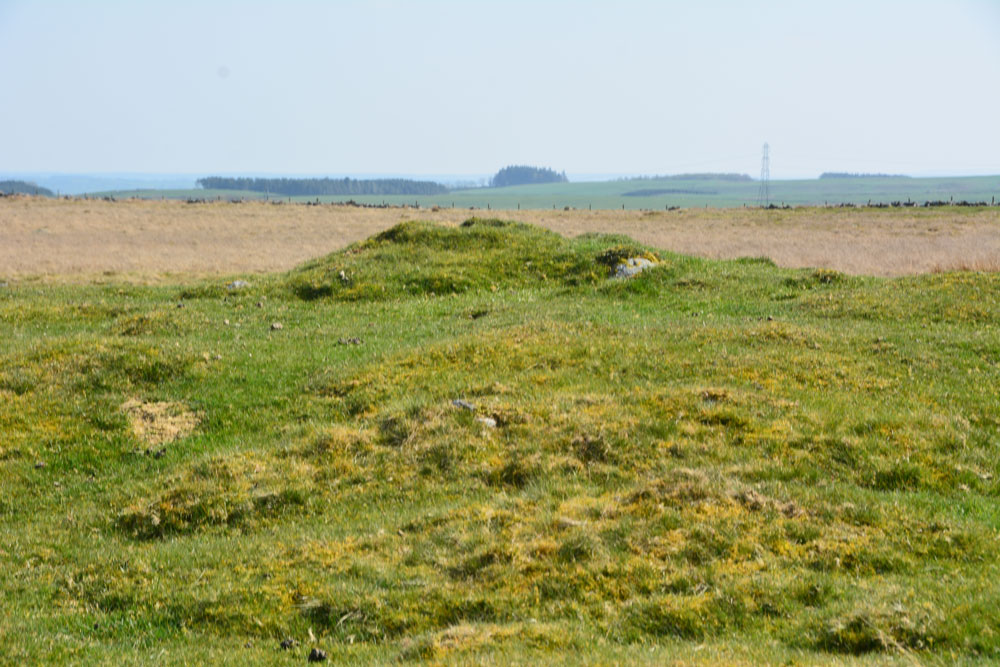
Howden Hill Middle Cairn submitted by Anne T on 26th Apr 2019. The middle cairn (middle of the photograph) as taken from the western-most of the three visible cairns at this location (stony foreground, now much levelled).
(View photo, vote or add a comment)
Log Text: Howden Hill Middle Cairn: From the rock art panels, it is only just over 150m to walk to this cairn, which is the most prominent of the two on this side of the ridge above Settlingstones Burn.
In a very lovely spot, the make up of the cairn from stones and earth becomes evident. It is around 9m in diameter and about 1m (perhaps slightly higher) above the surrounding ground level.
With its proximity to Hadrian’s Wall, the location of this cairn cemetery with its rock art, cists and cairns is intriguing. Sewingshields Crags is visible on the skyline to the south east.
Howden Hill 3
Trip No.125 Entry No.7 Date Added: 25th Apr 2019
Site Type: Rock Art
Country: England (Northumberland)
Visited: Yes on 20th Apr 2019. My rating: Condition 3 Ambience 4 Access 3
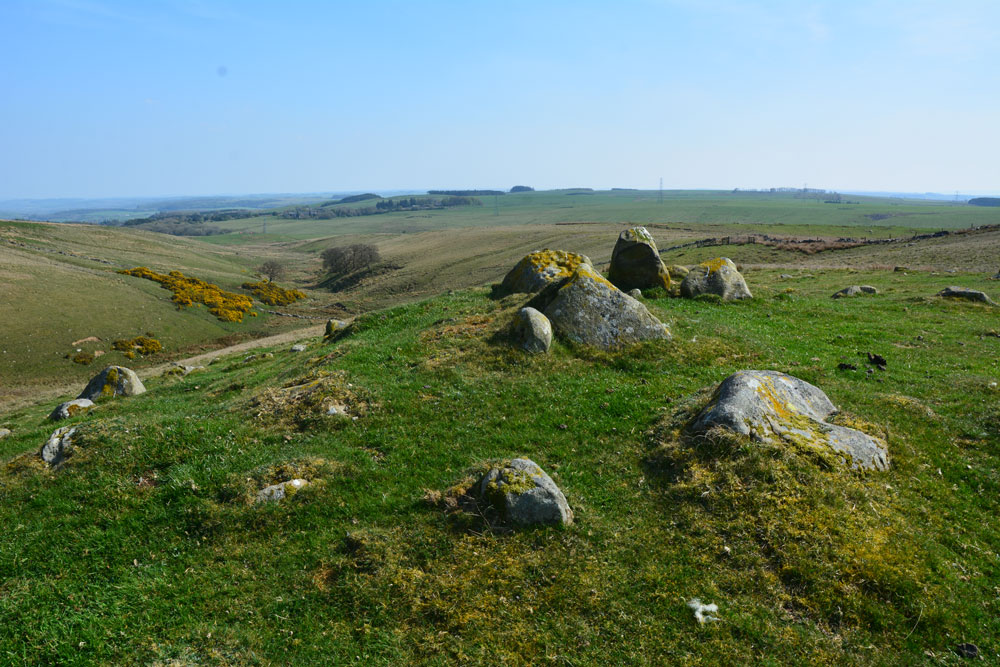
Howden Hill 3 submitted by Anne T on 24th Apr 2019. Photo showing the location of the cairn from its north western side, showing the steep slope down to Settlingstone Burn below.
(View photo, vote or add a comment)
Log Text: Howden Hill/Settlingstone Burn 3: Standing at the Howden Hill Rock Art Panels 1 and 2, two large stones and a large erratic were prominent on the skyline a couple of hundred metres to the east. They looked well worth investigating, so we followed the tractor trail up to the them. Wow. The location is lovely.
What a setting for the remains of this cairn, which sits high above Settlingstone Burn, at the top of a steep slope. The rock art panel within it is the most prominent of the stones within the cairn with its almost luminescent yellow/green lichen which served to highlight the cup marks. Whilst NADRAP/ERA says the cups may be caused by erosion, we thought they were pretty convincing, the outer cups being seemingly arranged in lines. If this was the original cist cover, it has been overturned at some time in the distant past.
Howden Hill Cist
Trip No.125 Entry No.4 Date Added: 25th Apr 2019
Site Type: Cist
Country: England (Northumberland)
Visited: Yes on 20th Apr 2019. My rating: Condition 3 Ambience 4 Access 3
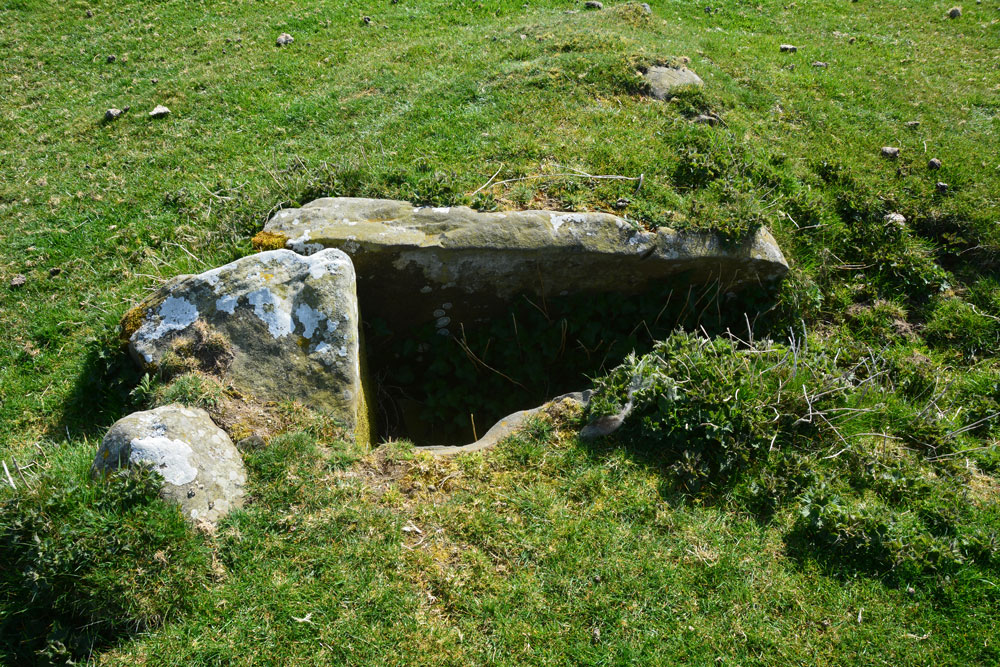
Howden Hill Cists submitted by Anne T on 25th Apr 2019. The possible stone lined cist at NY 83104 69692.
(View photo, vote or add a comment)
Log Text: Possible stone lined cist and stone setting on Howden Hill: Getting to the sheepfold near the two cairns and the rock art panels was a little challenging, as we had to cross electric fences, cross a number of field drains, boggy areas, and avoid the deep tufts and holes in some parts of the access land.
Thank goodness for the GPS. We headed for the centre of the southern side of the prominent sheepfold at NY 83080 69696, before min on trying to find the rock art panels to the east of the sheepfold.
Surprisingly, we found ourselves looking around in awe, as we found ourselves in the middle of what looked like a stone setting with a possible small standing stone and small lumps and bumps on the ground with stones protruding, which could be other cairns.
Walking towards the rock art panels, I stumbled across what I thought were two cairns and called Andrew and Jennifer back to take a look. We later found out at home that one of the cists (stone-lined trough) is only mentioned on the HE and ERA-1414 entries.
Just to the SW of the cists was a small standing stone at NY 83082 69685, which might be marking part of another cist/dolmen?
West Howden Hill
Trip No.125 Entry No.1 Date Added: 25th Apr 2019
Site Type: Ancient Village or Settlement
Country: England (Northumberland)
Visited: Yes on 20th Apr 2019. My rating: Condition 2 Ambience 4 Access 4
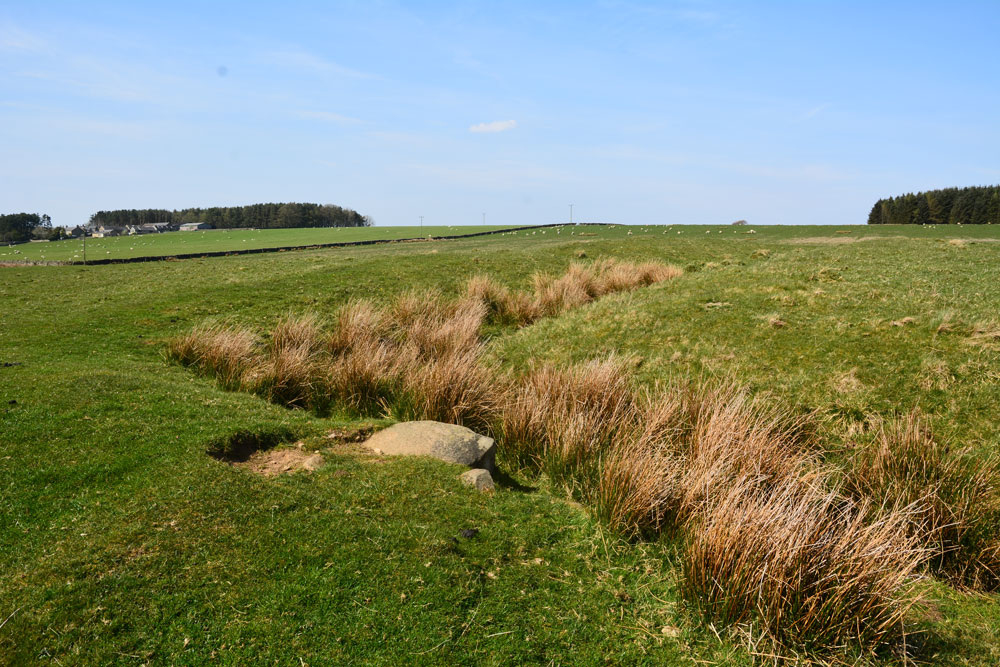
West Howden Hill submitted by Anne T on 25th Apr 2019. The south western corner of this Romano British settlement, looking north west towards the small forested area to the north of Grindon farm. This large farm can be seen just above centre-left of the photo.
(View photo, vote or add a comment)
Log Text: West Howden Hill RB Settlement: Unusually, our daughter joined us for this trip, as it was on her way to our house from Scotland, and we met outside the Old Repeater Station on the Old Military Road (B6318) and took one car the 1.4km down to the gate with the path leading to the access land on Howden Hill/Brown Moor.
This settlement straddles the marked track from North Road which runs from the Old Military Road and Old Repeater Station , past a large farm called Grindon, to reach the access land. We parked on the grass verge next to the gate into the field at NY 82336 69216 and made our way through the fields towards the location of the rock art.
There is no entry for this settlement on HE, but it is marked on their map as an enclosure.
I didn’t see this settlement until we were almost upon it. The outer ditches and banks are very clear, with an entrance half way along its eastern side. I also stopped to take photos on the way back, together with some large erratic boulders which lay next to the footpath. The site is gently sloping towards the south east and there are prominent boulders protruding from its central platform, although we could make out no discernible structures.
Howden Hill 1
Trip No.125 Entry No.2 Date Added: 24th Apr 2019
Site Type: Rock Art
Country: England (Northumberland)
Visited: Yes on 20th Apr 2019. My rating: Condition 3 Ambience 4 Access 3
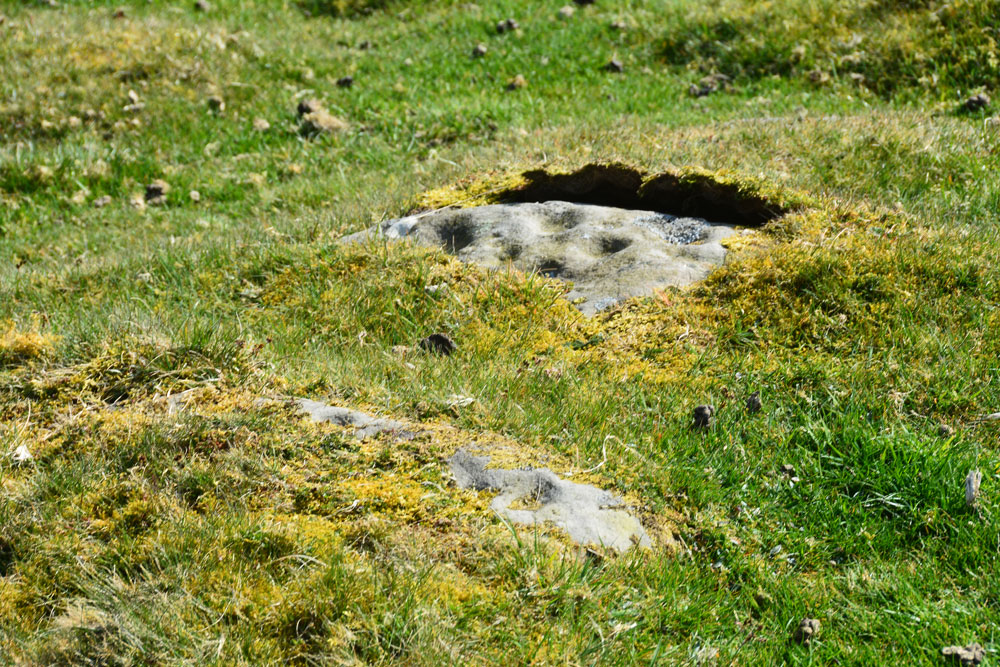
Howden Hill 1 submitted by Anne T on 24th Apr 2019. Howden Hill panels 1 and 2 together. Howden Hill 1 is the northern most panel, shown towards the bottom middle-left of the photograph, mostly covered in turf.
(View photo, vote or add a comment)
Log Text: Howden Hill 1: Rock Art panel within Bronze Age Stone setting, not far to the south of Hadrian's Wall. Setting is quite fascinating, comprising cists, cairns, low banks and rock art. We had not expected to see this cists, so this came as a nice surprise. Whilst we could see quite deep cups on this rock, most of it was covered by turf, so we left it alone to preserve it.
Immediately to the east of the easternmost of the two cists we saw, Historic England List ID 1418656 says: "The first and most northerly panel (ERA 1415) is roughly triangular in shape and dips steeply into the ground from an uncovered high point on its south edge; it is about 0.8m by 0.5m and is oriented east to west. There are about thirty cup marks scattered across the boulder and some appear to form slightly curved or straight lines".
Howden Hill 2
Trip No.125 Entry No.3 Date Added: 24th Apr 2019
Site Type: Rock Art
Country: England (Northumberland)
Visited: Yes on 20th Apr 2019. My rating: Condition 3 Ambience 4 Access 3
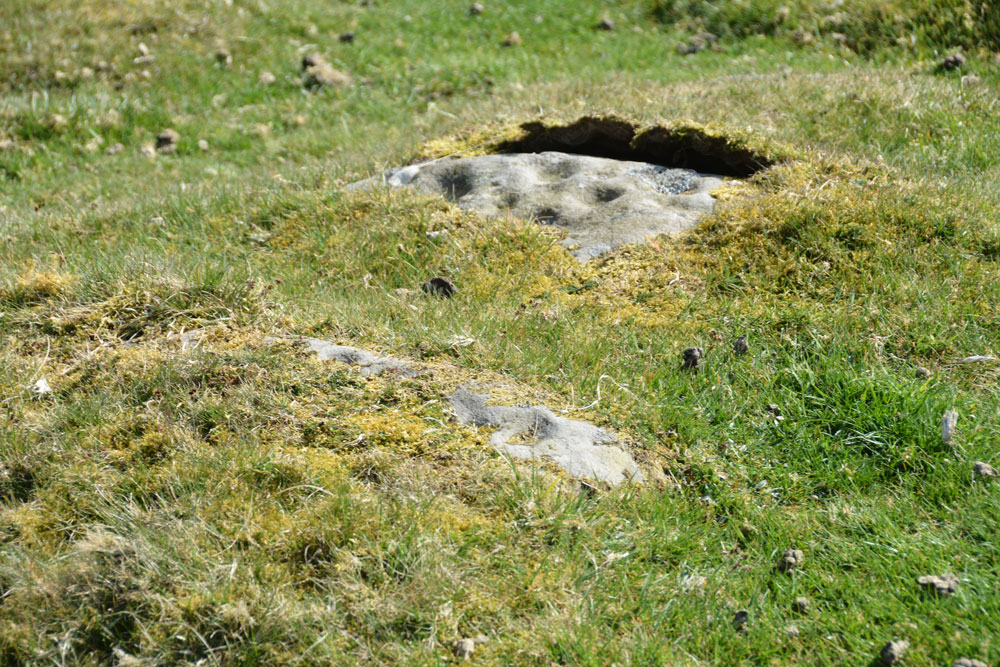
Howden Hill 2 submitted by Anne T on 24th Apr 2019. Howden Hill panels 1 and 2 shown together. Howden Hill 2 is the top-most panel in the photograph, probably less than 1 metre to the south of Howden Hill 1. We thought they were possibly part of the same outcrop, but looking at the ERA photographs, they are two separate stones, possibly the original cists covers of the nearby cists.
(View photo, vote or add a comment)
Log Text: Howden Hill 2: Literally 1m to the north of Howden Hill 1, and has most visible. It is clear that both rocks continue under the turf, but not wishing to cause any damage, viewed them as they were. Having seen Andy Curtis's photograph on Geograph beforehand, I'd expected both panels to be covered in turf, and was surprised to find the cups that were above ground were very visible in the strong sunlight. Both panels are to the east of the sheepfold and the two cists that we saw and went back to examine after photographing what was visible of these two RA panels.
Recorded as HE 1418656 and ERA-1414: "The second panel (ERA 1414) lies immediately to the south of the first, and is a rounded boulder about 0.9m across. there are more than fifty cup marks, again some forming prominent lines, curved arcs or more scattered groups; the latter are particularly clustered on the south and west sides. It is possible that the panels represent a broken, decorated cist cover".
St Cuthbert's Church (Wamphray)
Trip No.124 Entry No.4 Date Added: 5th Apr 2019
Site Type: Ancient Cross
Country: Scotland (Dumfries and Galloway)
Visited: Yes on 4th Apr 2019. My rating: Condition 3 Ambience 3 Access 4
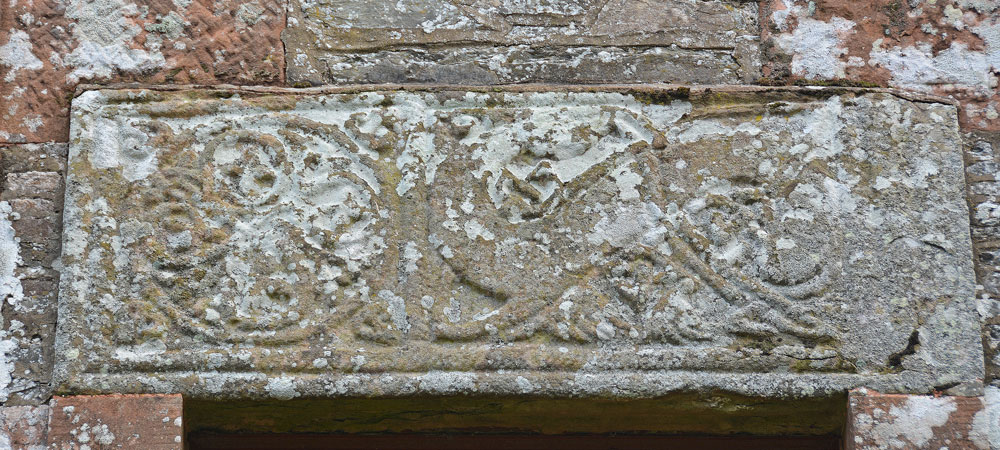
St Cuthbert's Church (Wamphray) submitted by Anne T on 5th Apr 2019. The Anglo Scandinavian cross slab above the west door of Wamphray Parish church, which is dedicated to St Cuthbert. Canmore tells us: "The front of the slab is divided into two panels by a cable moulding. The left panel is filled with a symmetrical knot formed by the interlacing of four plant scrolls, and that on the right by a backward-biting quadruped".
(View photo, vote or add a comment)
Log Text: Anglo Scandinavian Cross Slab, St Cuthbert's Church, Wamphray: This seemed far too modern a church to incorporate any old stones, but I was to be surprised. The churchyard was quite spectacular, with a large walled mausoleum and two very large monuments, one being a replica of a churchyard cross.
We found the stone over the west door of the church. It was an interesting exercise to photograph this, as the ground sloped down very steeply to the river. The stone was carved on its wide face, and also some interlacing on its underside, next to the door.
Sadly, the church was very firmly padlocked and doors locked, so we were unable to get to see the reverse side of the slab. There was a modern, recreation of a churchyard cross at the south side of the church, near the gate into the churchyard.
Poldean menhir
Trip No.124 Entry No.3 Date Added: 5th Apr 2019
Site Type: Standing Stone (Menhir)
Country: Scotland (Dumfries and Galloway)
Visited: Yes on 4th Apr 2019. My rating: Condition 3 Ambience 3 Access 4
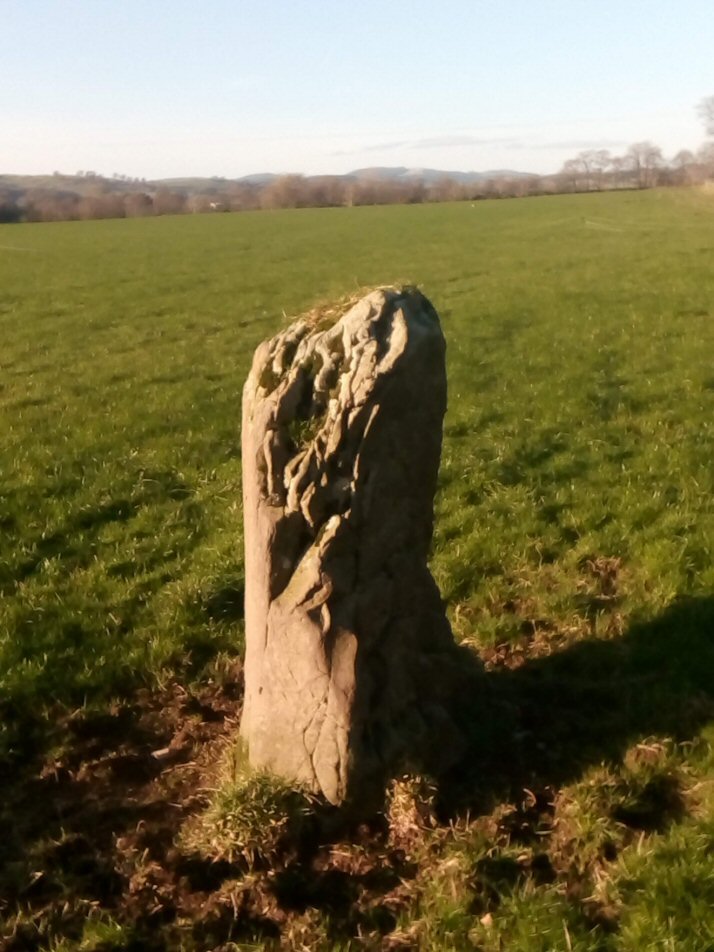
Poldean submitted by Apocryphus on 20th Jan 2019. A smaller stone located opposite Poldean Farm on a minor road south of Moffat
(View photo, vote or add a comment)
Log Text: Poldean Standing Stone: The third stop of the day with this stone easily visible just to the west of the road, towards the eastern edge of a large field of pasture.
We let ourselves in through the gate NY 10424 99981, walking over a small stream, again with the River Annan to its west and the busy A754(M) in the distance.
The eastern side of the stone is very craggy, as if bedding planes have been worn/broken away. There appears to have been a cup low down on its western side, but this could be a solution hole, if the stone had been lying flat for some considerable time in the past.
Chapman's Stone
Trip No.124 Entry No.2 Date Added: 5th Apr 2019
Site Type: Standing Stone (Menhir)
Country: Scotland (Dumfries and Galloway)
Visited: Yes on 4th Apr 2019. My rating: Condition 3 Ambience 3 Access 5

Chapman's Stone submitted by Anne T on 5th Apr 2019. Standing just to the west of stone, looking eastwards. The end of the stone nearest us is the tapered end, which would have been the top of the stone when it stood upright.
(View photo, vote or add a comment)
Log Text: Chapman's Stone: Our second stop of the day, and easy to stop alongside the road where it widens slightly, at NY 10746 99049 and walked back the short way to the stone. The stone has a fence built right over the middle of it (it looks like it could be used as a stile). It’s eastern side looks as if it has been knocked and broken by farm equipment. Looking at where the stone is placed in the landscape, it is along an old drover’s road, with the River Annan to its western side; to the NE, there are two flat topped hills in the distance.
